Evaluation of MAX-DOAS Profile Retrievals under Different Vertical Resolutions of Aerosol and NO2 Profiles and Elevation Angles
Abstract
:1. Introduction
2. Instrumentation and Methodology
2.1. Site Description
2.2. MAX-DOAS and Lidar Setup
2.3. DOAS Analysis and Profile Retrieval
2.3.1. Spectral Analysis
2.3.2. Profile Retrievals
2.4. Analysis Strategy and RTM Parameters
2.5. Pretreatment of Lidar Aerosol Profiles
3. Results and Discussion
3.1. Aerosol Results
3.1.1. Effect on the Aerosol Profile Retrieval
3.1.2. The Aerosol Profile Retrieval in MAX-DOAS Observations
3.1.3. Lidar Results as the Input Aerosol Profile
3.2. NO2 Results
3.2.1. Effect of Vertical Resolution and Elevation Angles on NO2 Profile Retrieval
3.2.2. NO2 Profile Retrieval in MAX-DOAS Observations
3.2.3. Lidar Profiles as Aerosol Profiles in NO2 Profile Retrievals
3.3. Discussion
4. Conclusions
Supplementary Materials
Author Contributions
Funding
Data Availability Statement
Acknowledgments
Conflicts of Interest
References
- Hönninger, G.; von Friedeburg, C.; Platt, U. Multi axis differential optical absorption spectroscopy (MAX-DOAS). Atmos. Chem. Phys. 2004, 4, 231–254. [Google Scholar] [CrossRef]
- Wagner, T.; Dix, B.; von Friedeburg, C.; Friess, U.; Sanghavi, S.; Sinreich, R.; Platt, U. MAX-DOAS O4 measurements: A new technique to derive information on atmospheric aerosols—Principles and information content. J. Geophys. Res. Atmos. 2004, 109. [Google Scholar] [CrossRef]
- Heckel, A.; Richter, A.; Tarsu, T.; Wittrock, F.; Hak, C.; Pundt, I.; Junkermann, W.; Burrows, J.P. MAX-DOAS measurements of formaldehyde in the Po-Valley. Atmos. Chem. Phy. 2005, 5, 909–918. [Google Scholar] [CrossRef]
- Friess, U.; Monks, P.S.; Remedios, J.J.; Rozanov, A.; Sinreich, R.; Wagner, T.; Platt, U. MAX-DOAS O4 measurements: A new technique to derive information on atmospheric aerosols: 2. Modeling studies. J. Geophys. Res.-Atmos. 2006, 111, D14. [Google Scholar] [CrossRef]
- Platt, U.; Stutz, J. Differential Optical Absorption Spectroscopy, Principles and Applications; Springer: Berlin/Heidelberg, Germany, 2008; pp. 314–330. [Google Scholar]
- Irie, H.; Kanaya, Y.; Akimoto, H.; Iwabuchi, H.; Shimizu, A.; Aoki, K. First retrieval of tropospheric aerosol profiles using MAX-DOAS and comparison with lidar and sky radiometer measurements. Atmos. Chem. Phys. 2008, 8, 341–350. [Google Scholar] [CrossRef]
- Tian, X.; Xu, J.; Xie, P.H.; Li, A.; Hu, Z.K.; Li, X.M.; Ren, B.; Wu, Z.Y. Retrieving Tropospheric Vertical Distribution in HCHO by Multi-Axis Differential Optical Absorption Spectroscopy. Spectrosc. Spect. Anal. 2019, 39, 2325–2331. [Google Scholar]
- Ma, J.Z.; Dörner, S.; Donner, S.; Jin, J.L.; Cheng, S.Y.; Guo, J.R.; Zhang, Z.F.; Wang, J.Q.; Liu, P.; Zhang, G.Q.; et al. MAX-DOAS measurements of NO2, SO2, HCHO, and BrO at the Mt. Waliguan WMO GAW global baseline station in the Tibetan Plateau. Atmos. Chem. Phys. 2020, 20, 6973–6990. [Google Scholar] [CrossRef]
- Ma, J.Z.; Beirle, S.; Jin, J.L.; Shaiganfar, R.; Yan, P.; Wagner, T. Tropospheric NO2 vertical column densities over Beijing: Results of the first three years of ground-based MAX-DOAS measurements (2008–2011) and satellite validation. Atmos. Chem. Phys. 2013, 13, 1547–1567. [Google Scholar] [CrossRef]
- Javed, Z.; Tanvir, A.; Bilal, M.; Su, W.J.; Xia, C.Z.; Rehman, A.; Zhang, Y.Y.; Sandhu, O.; Xing, C.Z.; Ji, X.; et al. Recommendations for HCHO and SO2 Retrieval Settings from MAX-DOAS Observations under Different Meteorological Conditions. Remote Sens. 2021, 13, 2244. [Google Scholar] [CrossRef]
- Hendrick, F.; Müller, J.-F.; Clémer, K.; Wang, P.; De Mazière, M.; Fayt, C.; Gielen, C.; Hermans, C.; Ma, J.Z.; Pinardi, G.; et al. Four years of ground-based MAX-DOAS observations of HONO and NO2 in the Beijing area. Atmos. Chem. Phys. 2014, 14, 765–781. [Google Scholar] [CrossRef]
- Kanaya, Y.; Irie, H.; Takashima, H.; Iwabuchi, H.; Akimoto, H.; Sudo, K.; Gu, M.; Chong, J.; Kim, Y.J.; Lee, H.; et al. Long-term MAX-DOAS network observations of NO2 in Russia and Asia (MADRAS) during the period 2007–2012: Instrumentation, elucidation of climatology, and comparisons with OMI satellite observations and global model simulations. Atmos. Chem. Phys. 2014, 14, 7909–7927. [Google Scholar] [CrossRef]
- Wang, T.; Wang, P.; Theys, N.; Tong, D.; Hendrick, F.; Zhang, Q.; Van Roozendael, M. Spatial and temporal changes in SO2 regimes over China in the recent decade and the driving mechanism. Atmos. Chem. Phys. 2018, 18, 18063–18078. [Google Scholar] [CrossRef]
- Wang, Y.; Lampel, J.; Xie, P.; Beirle, S.; Li, A.; Wu, D.; Wagner, T. Ground-based MAX-DOAS observations of tropospheric aerosols, NO2, SO2 and HCHO in Wuxi, China, from 2011 to 2014. Atmos. Chem. Phys. 2017, 17, 2189–2215. [Google Scholar] [CrossRef]
- Luo, Y.H.; Dou, S.K.; Fan, G.; Huang, S.; Si, F.; Zhou, H.; Wang, Y.; Pei, C.; Tang, F.; Yang, D.; et al. Vertical distributions of tropospheric formaldehyde, nitrogen dioxide, ozone and aerosol in southern China by ground-based MAX-DOAS and LIDAR measurements during PRIDE-GBA 2018 campaign. Atmos. Environ. 2020, 226, 117384. [Google Scholar] [CrossRef]
- Zhang, J.; Wang, S.; Guo, Y.L.; Zhang, R.F.; Qin, X.F.; Huang, K.; Wang, D.F.; Fu, Q.Y.; Wang, J.; Zhou, B. Aerosol vertical profile retrieved from ground-based MAX-DOAS observation and characteristic distribution during wintertime in Shanghai, China. Atmos. Environ. 2018, 192, 193–205. [Google Scholar] [CrossRef]
- Rodgers, C.D. Inverse Methods for Atmospheric Sounding—Theory and Practice, Series on Atmospheric, Oceanic and Planetary Physics—Volume 2; World Scientific Publishing Co., Pte. Ltd.: Singapore, 2000. [Google Scholar] [CrossRef]
- Frieß, U.; Beirle, S.; Alvarado Bonilla, L.; Bösch, T.; Friedrich, M.M.; Hendrick, F.; Piters, A.; Richter, A.; van Roozendael, M.; Rozanov, V.V.; et al. Intercomparison of MAX-DOAS vertical profile retrieval algorithms: Studies using synthetic data. Atmos. Meas. Tech. 2019, 12, 2155–2181. [Google Scholar] [CrossRef]
- Tirpitz, J.-L.; Frieß, U.; Hendrick, F.; Alberti, C.; Allaart, M.; Apituley, A.; Bais, A.; Beirle, S.; Berkhout, S.; Bognar, K.; et al. Intercomparison of MAX-DOAS vertical profile retrieval algorithms: Studies on field data from the CINDI-2 campaign. Atmos. Meas. Tech. 2021, 14, 1–35. [Google Scholar] [CrossRef]
- Vlemmix, T.; Hendrick, F.; Pinardi, G.; De Smedt, I.; Fayt, C.; Hermans, C.; Piters, A.; Wang, P.; Levelt, P.; Van Roozendael, M. MAX-DOAS observations of aerosols, formaldehyde and nitrogen dioxide in the Beijing area: Comparison of two profile retrieval approaches. Atmos. Meas. Tech. 2015, 8, 941–963. [Google Scholar] [CrossRef]
- Hartl, A.; Wenig, M.O. Regularisation model study for the least-squares retrieval of aerosol extinction time series from UV/VIS MAX-DOAS observations for a ground layer profile parameterisation. Atmos. Meas. Tech. 2013, 6, 1959–1980. [Google Scholar] [CrossRef]
- Tian, X.; Wang, Y.; Beirle, S.; Xie, P.; Wagner, T.; Xu, J.; Li, A.; Dörner, S.; Ren, B.; Li, X. Technical note: Evaluation of profile retrievals of aerosols and trace gases for MAX-DOAS measurements under different aerosol scenarios based on radiative transfer simulations. Atmos. Chem. Phys. 2021, 21, 12867–12894. [Google Scholar] [CrossRef]
- Wang, Y.; Apituley, A.; Bais, A.; Beirle, S.; Benavent, N.; Borovski, A.; Bruchkouski, I.; Chan, K.L.; Donner, S.; Drosoglou, T.; et al. Inter-comparison of MAX-DOAS measurements of tropospheric HONO slant column densities and vertical profiles during the CINDI-2 campaign. Atmos. Meas. Tech. 2020, 13, 5087–5116. [Google Scholar] [CrossRef]
- Frieß, U.; Baltink, H.K.; Beirle, S.; Clémer, K.; Hendrick, F.; Henzing, B.; Irie, H.; de Leeuw, G.; Li, A.; Moerman, M.M.; et al. Intercomparison of aerosol extinction profiles retrieved from MAX-DOAS measurements. Atmos. Meas. Tech. 2016, 9, 3205–3222. [Google Scholar] [CrossRef]
- Irie, H.; Takashima, H.; Kanaya, Y.; Boersma, K.F.; Gast, L.; Wittrock, F.; Brunner, D.; Zhou, Y.; Van Roozendael, M. Eight-component retrievals from ground-based MAX-DOAS observations. Atmos. Meas. Tech. 2011, 4, 1027–1044. [Google Scholar] [CrossRef]
- Bösch, T.; Rozanov, V.; Richter, A.; Peters, E.; Rozanov, A.; Wittrock, F.; Merlaud, A.; Lampel, J.; Schmitt, S.; de Haij, M.; et al. BOREAS—A new MAX-DOAS profile retrieval algorithm for aerosols and trace gases. Atmos. Meas. Tech. 2018, 11, 6833–6859. [Google Scholar] [CrossRef]
- Ren, B.; Xie, P.; Xu, J.; Li, A.; Qin, M.; Hu, R.; Zhang, T.; Fan, G.; Tian, X.; Zhu, W.; et al. Vertical characteristics of NO2 and HCHO, and the ozone formation regimes in Hefei, China. Sci. Total Environ. 2022, 823, 153425. [Google Scholar] [CrossRef]
- Wang, X.; Zhang, T.; Xiang, Y.; Lv, L.; Fan, G.; Ou, J. Investigation of atmospheric ozone during summer and autumn in Guangdong Province with a lidar network. Sci. Total Environ. 2021, 751, 141740. [Google Scholar] [CrossRef]
- Fan, G.; Zhang, T.; Fu, Y.; Dong, Y.; Liu, W. Temporal and spatial distribution characteristics of ozone based on differential absorption lidar in Beijing. Chin. J. Lasers 2014, 41, 1014003. [Google Scholar]
- Kreher, K.; Van Roozendael, M.; Hendrick, F.; Apituley, A.; Dimitropoulou, E.; Friess, U.; Richter, A.; Wagner, T.; Lampel, J.; Abuhassan, N.; et al. Intercomparison of NO2, O4, O3 and HCHO slant column measurements by MAX-DOAS and zenith-sky UV-visible spectrometers during CINDI-2. Atmos. Meas. Tech. 2020, 13, 2169–2208. [Google Scholar] [CrossRef]
- Vandaele, A.C.; Hermans, C.; Simon, P.C.; Carleer, M.; Colin, R.; Fally, S.; Merienne, M.F.; Jenouvrier, A.; Coquart, B. Measurements of the NO2 absorption cross-section from 42,000 cm−1 to 10,000 cm−1 (238–1000 nm) at 220 K and 294 K. J. Quant. Spectrosc. Radiat. Transf. 1998, 59, 171–184. [Google Scholar] [CrossRef]
- Thalman, R.; Volkamer, R. Temperature dependent absorption cross-sections of O2–O2 collision pairs between 340 and 630 nm and at atmospherically relevant pressure. Phys. Chem. Chem. Phys. 2013, 15, 15371–15381. [Google Scholar] [CrossRef]
- Serdyuchenko, A.; Gorshelev, V.; Weber, M.; Chehade, W.; Burrows, J.P. High spectral resolution ozone absorption cross-sections—Part 2: Temperature dependence. Atmos. Meas. Tech. 2014, 7, 625–636. [Google Scholar] [CrossRef]
- Meller, R.; Moortgat, G.K. Temperature dependence of the absorption cross sections of formaldehyde between 223 and 323 K in the wavelength range 225–375 nm. J. Geophys. Res -Atmos. 2000, 105, 7089–7101. [Google Scholar] [CrossRef]
- Fleischmann, O.C.; Hartmann, M.; Burrows, J.P.; Orphal, J. New ultraviolet absorption cross-sections of BrO at atmospheric temperatures measured by time-windowing Fourier transform spectroscopy. J. Photochem. Photobiol. A Chem. 2004, 168, 117–132. [Google Scholar] [CrossRef]
- Wagner, T.; Beirle, S.; Deutschmann, T. Three-dimensional simulation of the Ring effect in observations of scattered sun light using Monte Carlo radiative transfer models. Atmos. Meas. Tech. 2009, 2, 113–124. [Google Scholar] [CrossRef]
- Wang, Y.; Li, A.; Xie, P.H.; Chen, H.; Mou, F.S.; Xu, J.; Wu, F.C.; Zeng, Y.; Liu, J.G.; Liu, W.Q. Measuring tropospheric vertical distribution and vertical column density of NO2 by multi-axis differential optical absorption spectroscopy. Acta Phys. Sin.-Ch. Ed. 2013, 62, 20. [Google Scholar] [CrossRef]
- Wang, Y.; Beirle, S.; Hendrick, F.; Hilboll, A.; Jin, J.; Kyuberis, A.A.; Lampel, J.; Li, A.; Luo, Y.; Lodi, L.; et al. MAX-DOAS measurements of HONO slant column densities during the MAD-CAT campaign: Inter-comparison, sensitivity studies on spectral analysis settings, and error budget. Atmos. Meas. Tech. 2017, 10, 3719–3742. [Google Scholar] [CrossRef]
- Rozanov, A.; Rozanov, V.; Buchwitz, M.; Kokhanovsky, A.; Burrows, J.P. SCIATRAN 2.0—A new radiative transfer model for geophysical applications in the 175–2400 nm spectral region. Adv. Space Res. 2005, 36, 1015–1019. [Google Scholar] [CrossRef]
- Liu, Q.; Ding, W.D.; Xie, L.Q.; Zhang, J.; Zhu, J.; Xia, X.A.; Liu, D.Y.; Yuan, R.; Fu, Y. Aerosol properties over an urban site in central East China derived from ground sun-photometer measurements. Sci. China Earth Sci. 2017, 60, 297–314. [Google Scholar] [CrossRef]
- Vlemmix, T.; Piters, A.J.M.; Berkhout, A.J.C.; Gast, L.F.L.; Wang, P.; Levelt, P.F. Ability of the MAX-DOAS method to derive profile information for NO: Can the boundary layer and free troposphere be separated? Atmos. Meas. Tech. 2011, 4, 2659–2684. [Google Scholar] [CrossRef]
- Gratsea, M.; Bösch, T.; Kokkalis, P.; Richter, A.; Vrekoussis, M.; Kazadzis, S.; Tsekeri, A.; Papayannis, A.; Mylonaki, M.; Amiridis, V.; et al. Retrieval and evaluation of tropospheric-aerosol extinction profiles using multi-axis differential optical absorption spectroscopy (MAX-DOAS) measurements over Athens, Greece. Atmos. Meas. Tech. 2021, 14, 749–767. [Google Scholar] [CrossRef]
- Karagkiozidis, D.; Friedrich, M.M.; Beirle, S.; Bais, A.; Hendrick, F.; Voudouri, K.A.; Fountoulakis, I.; Karanikolas, A.; Tzoumaka, P.; Van Roozendael, M.; et al. Retrieval of tropospheric aerosol, NO2, and HCHO vertical profiles from MAX-DOAS observations over Thessaloniki, Greece: Intercomparison and validation of two inversion algorithms. Atmos. Meas. Tech. 2022, 15, 1269–1301. [Google Scholar] [CrossRef]
- NASA. US Standard Atmosphere, Office, U.S.; Government Printing: Washington, DC, USA, 1976. [Google Scholar]
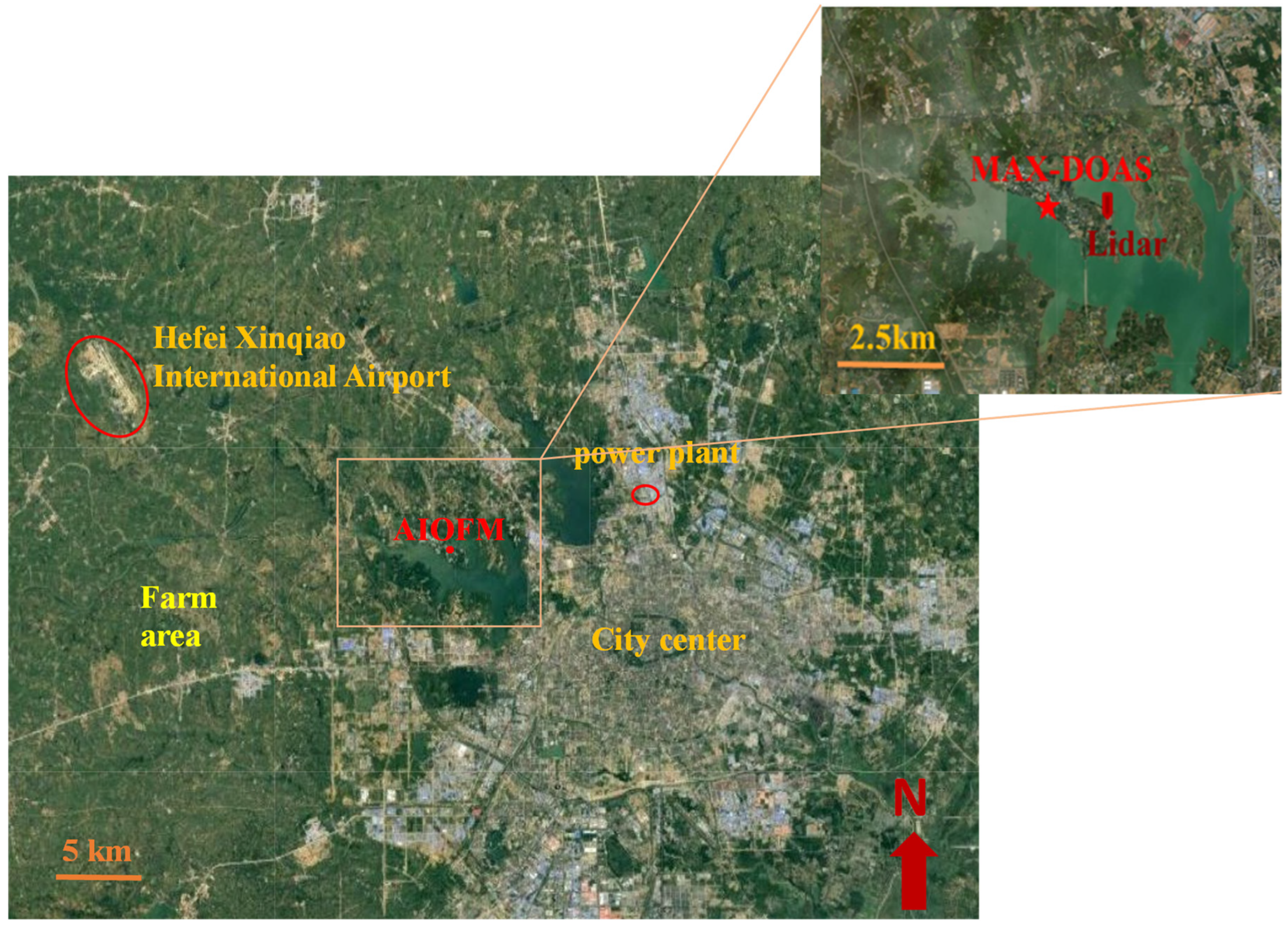
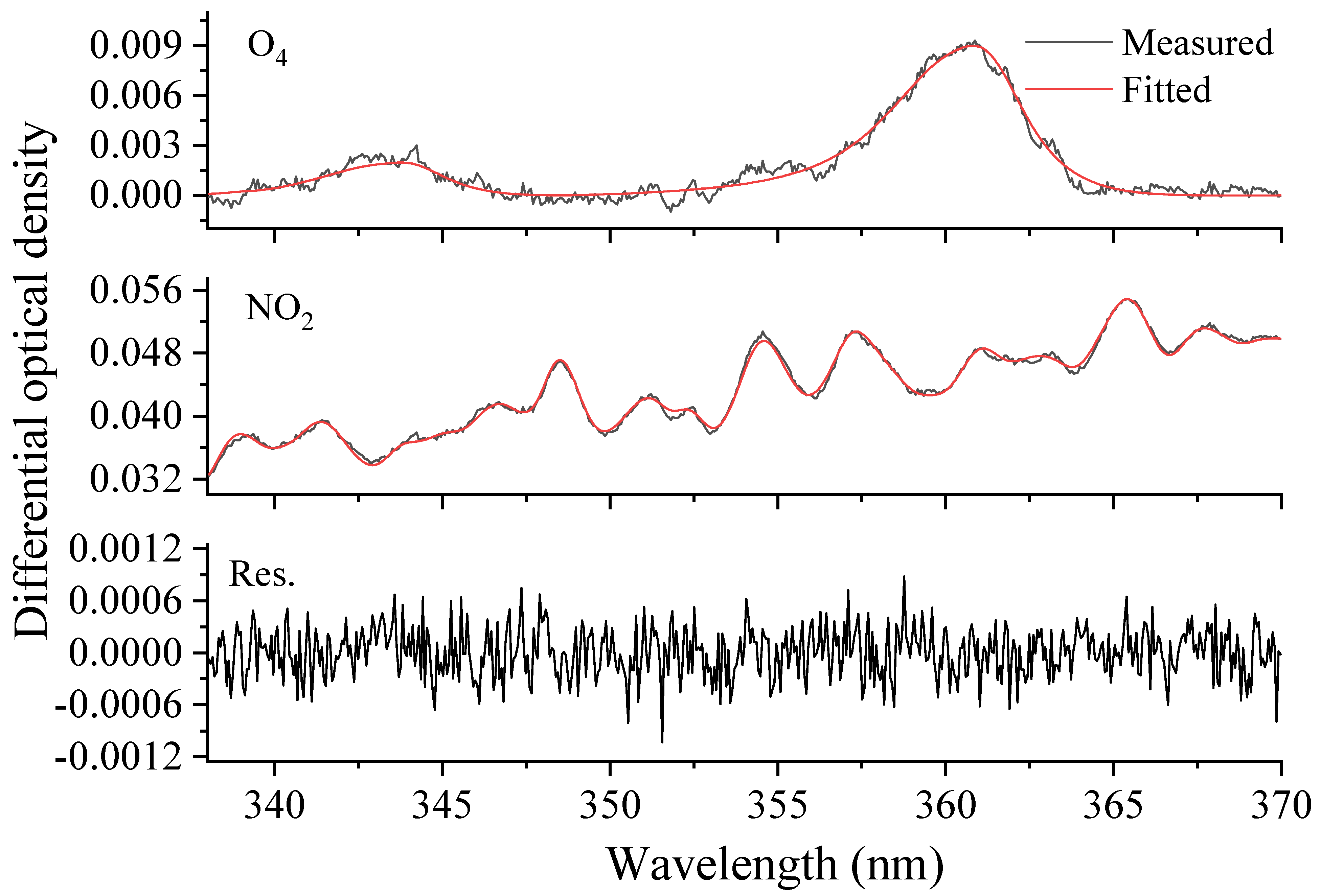



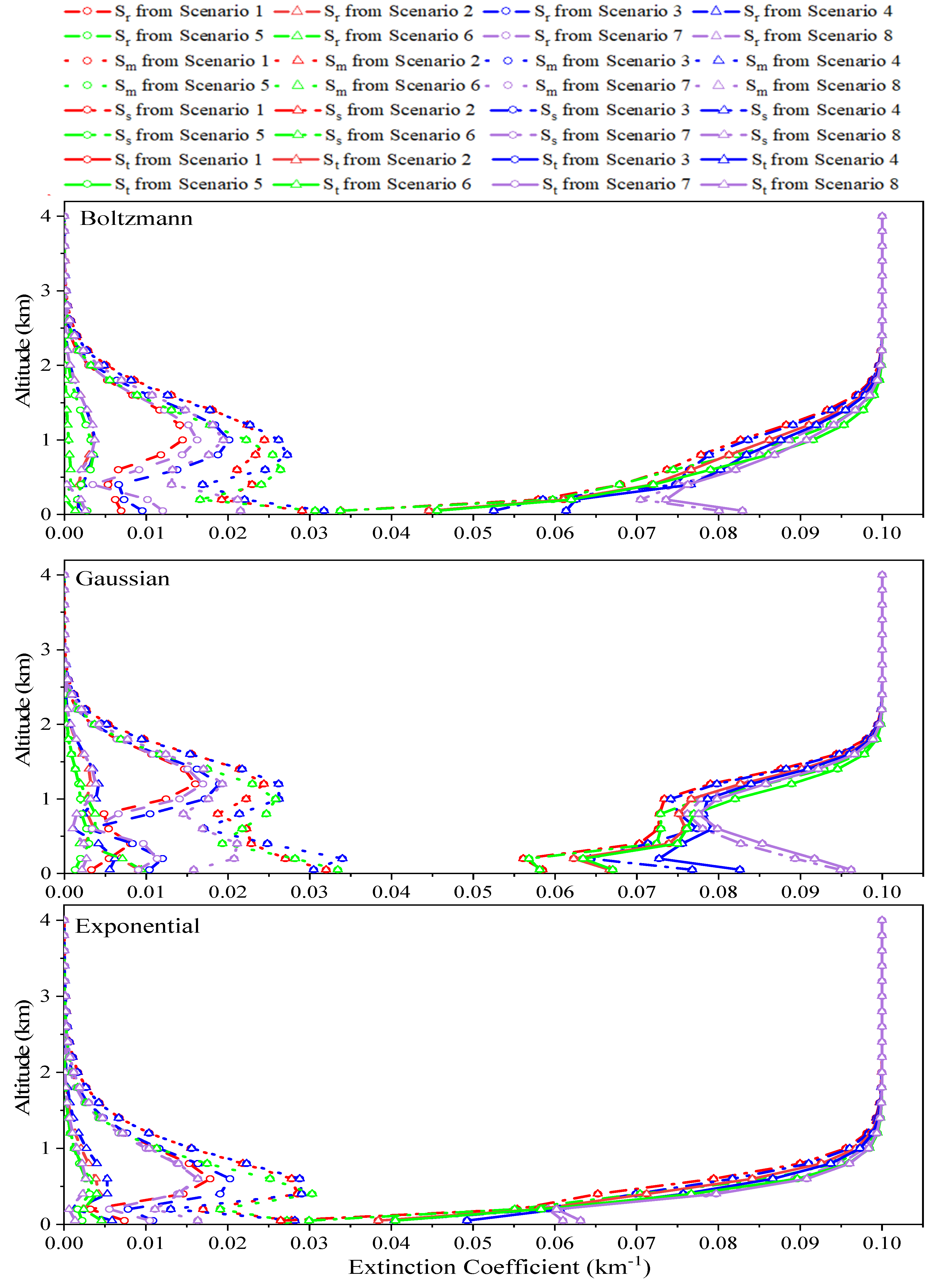
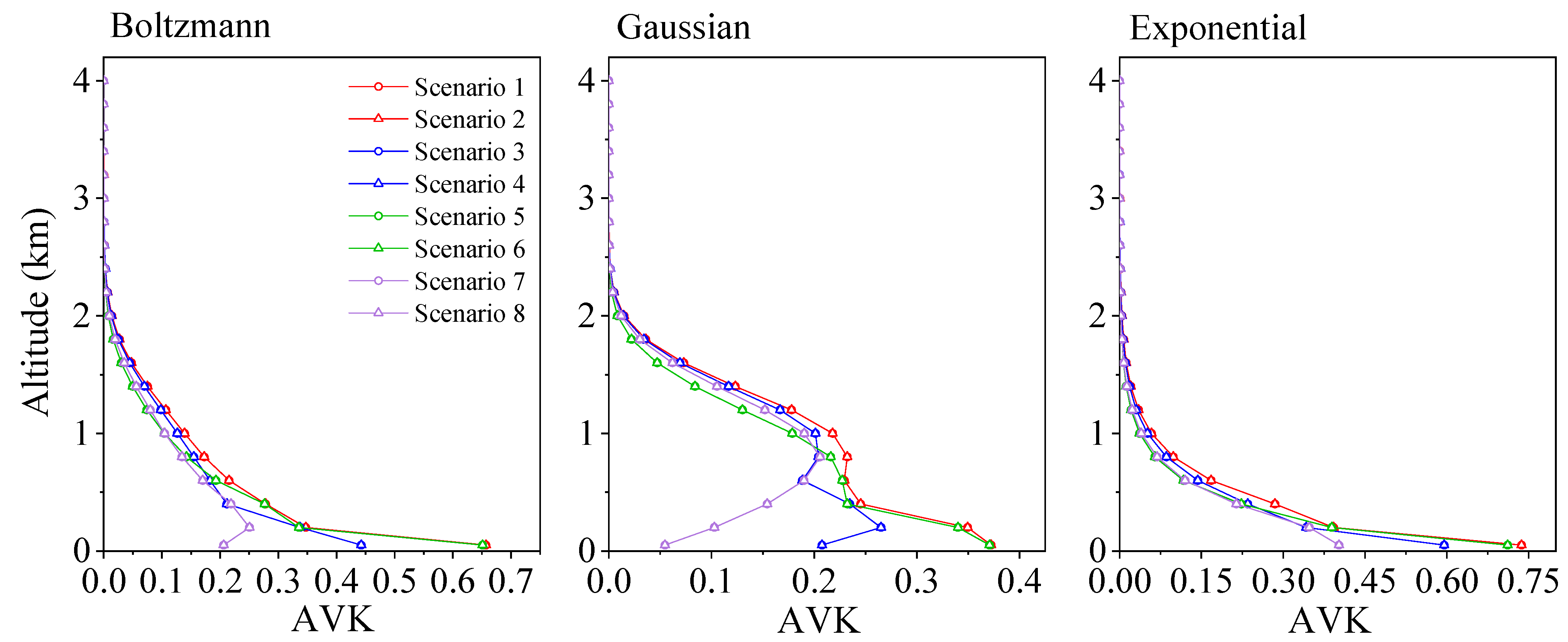
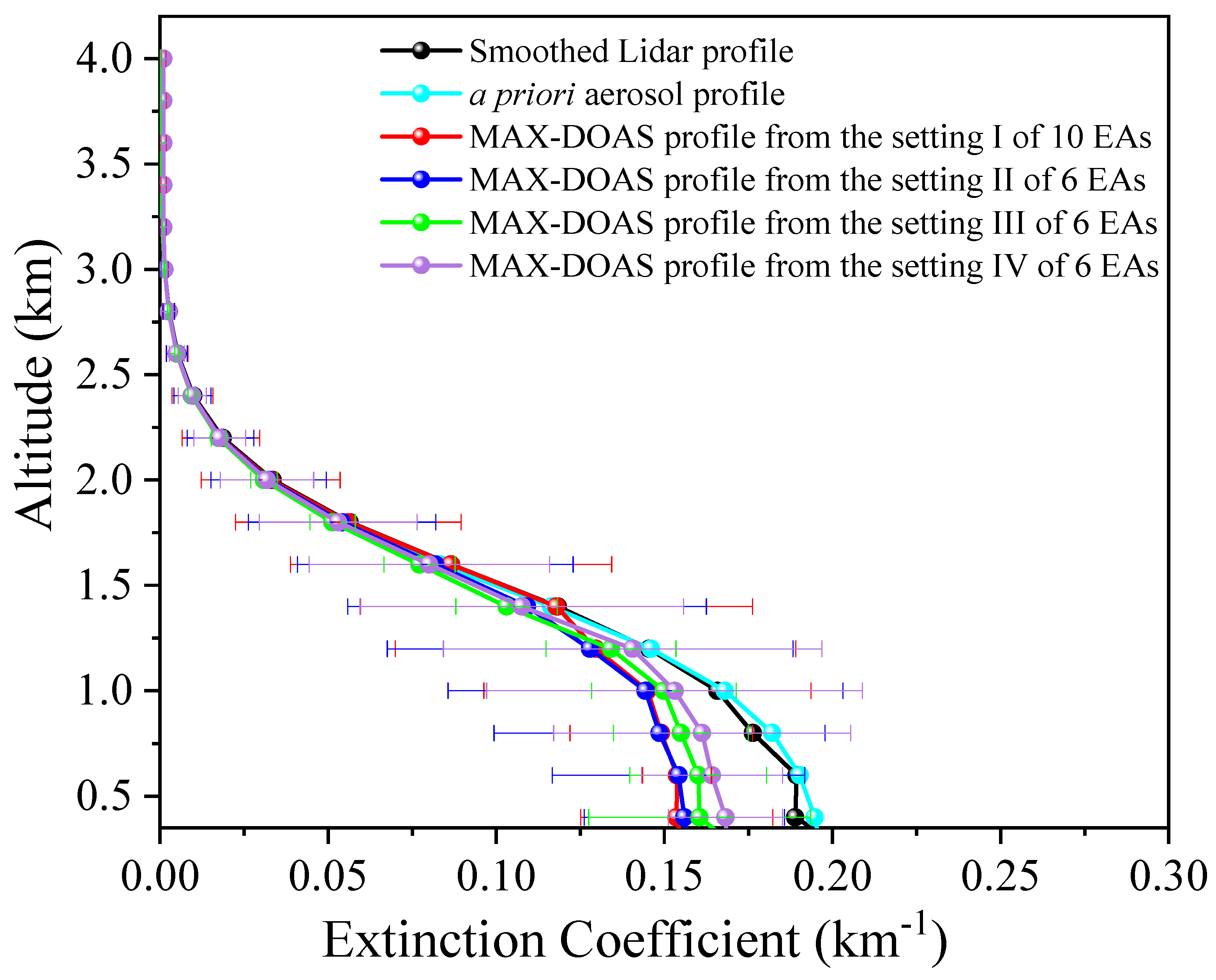
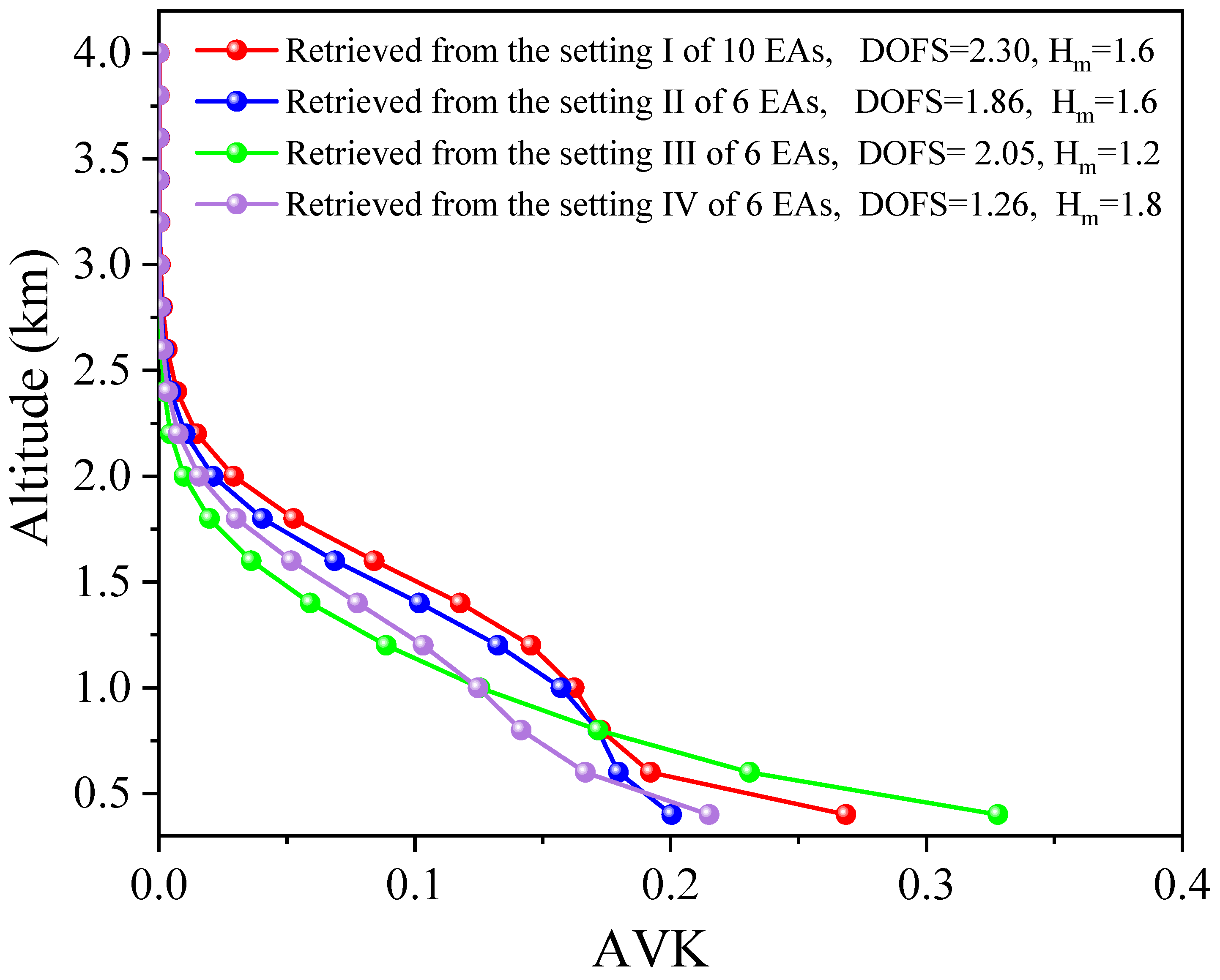

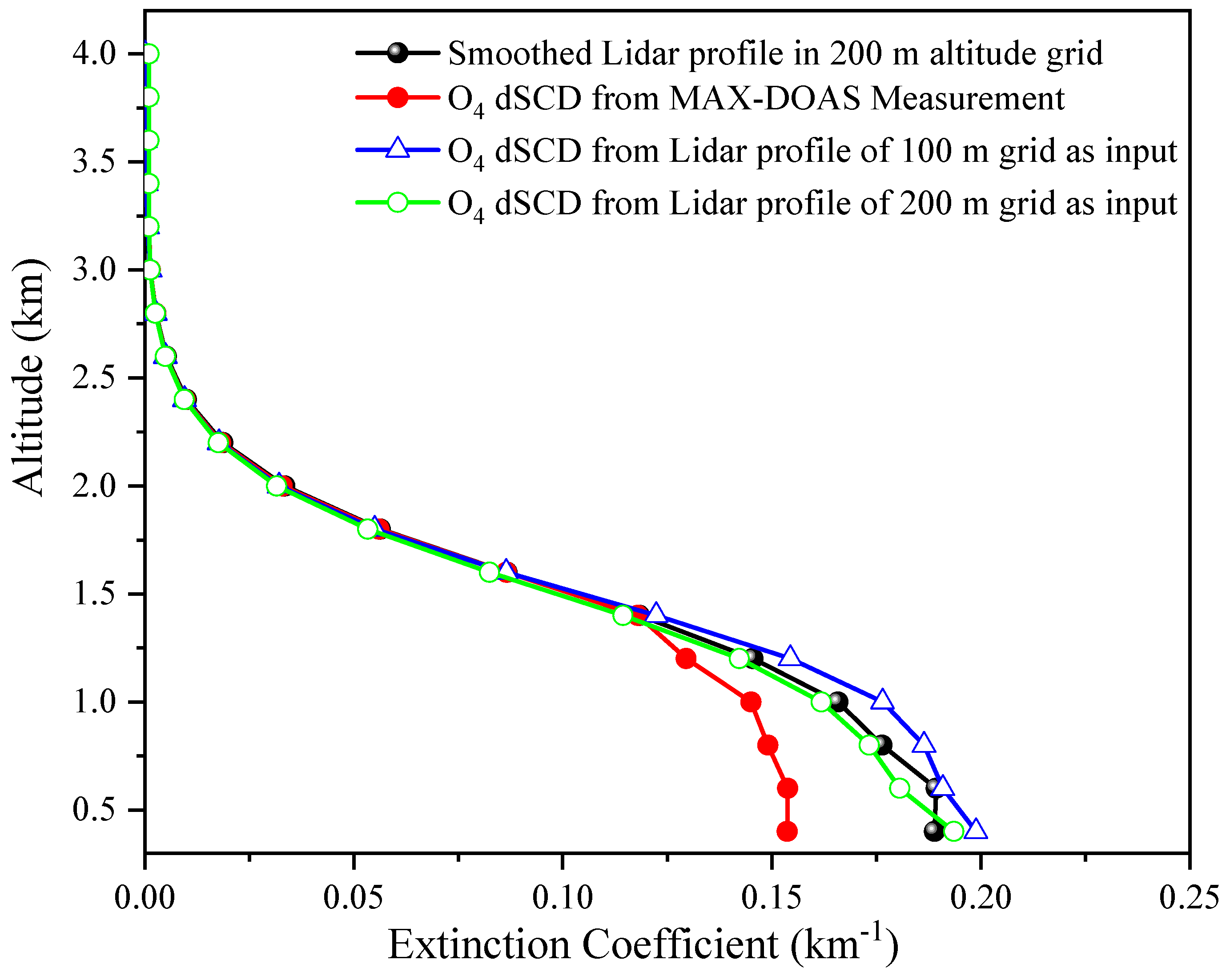
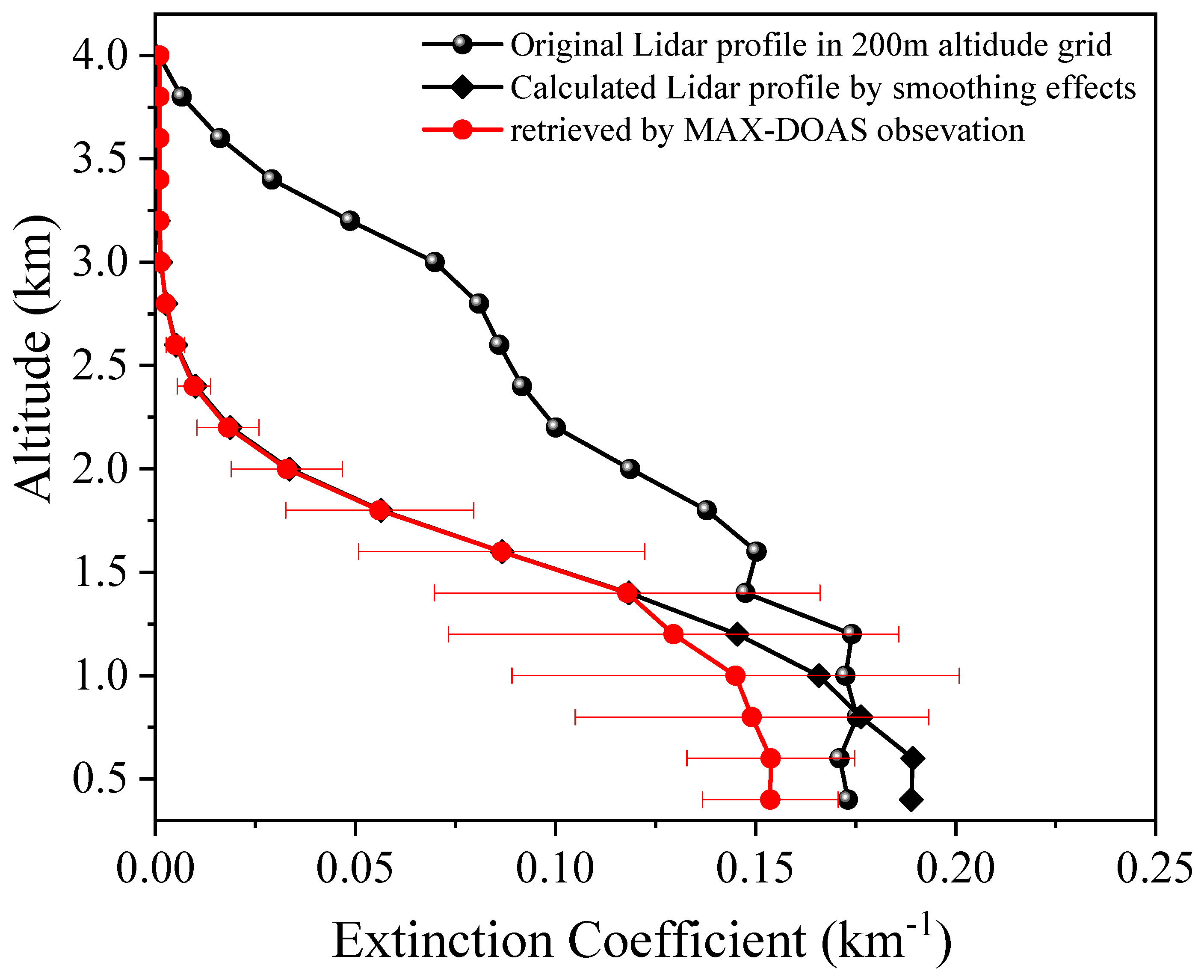



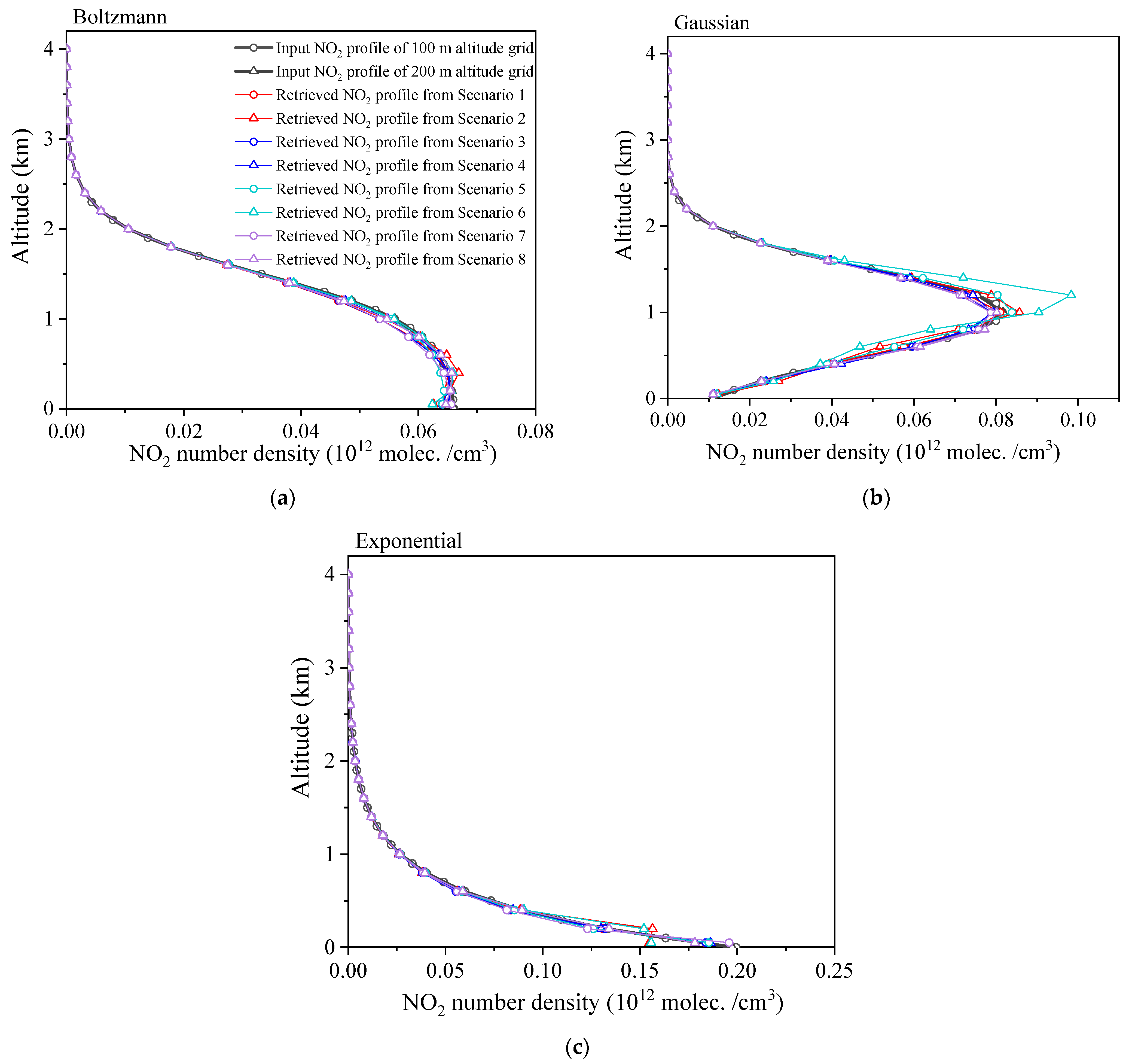
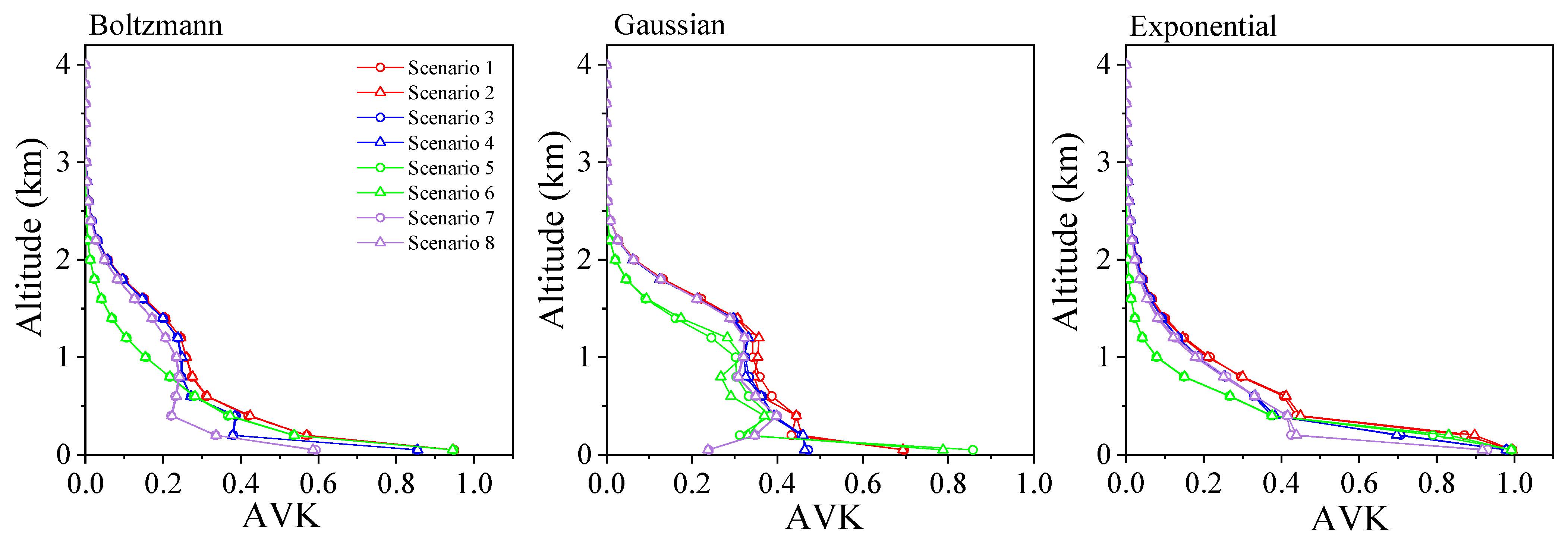

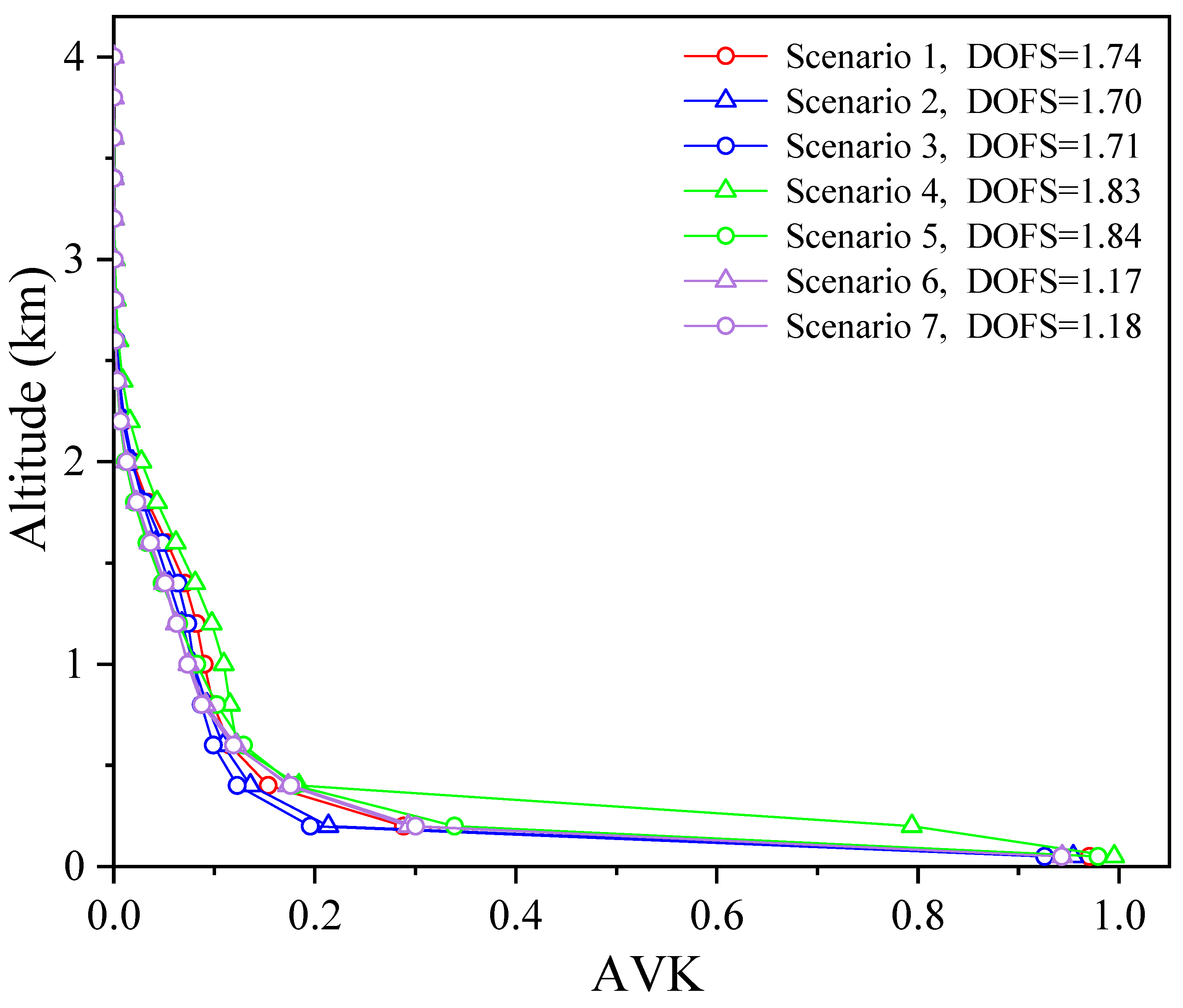
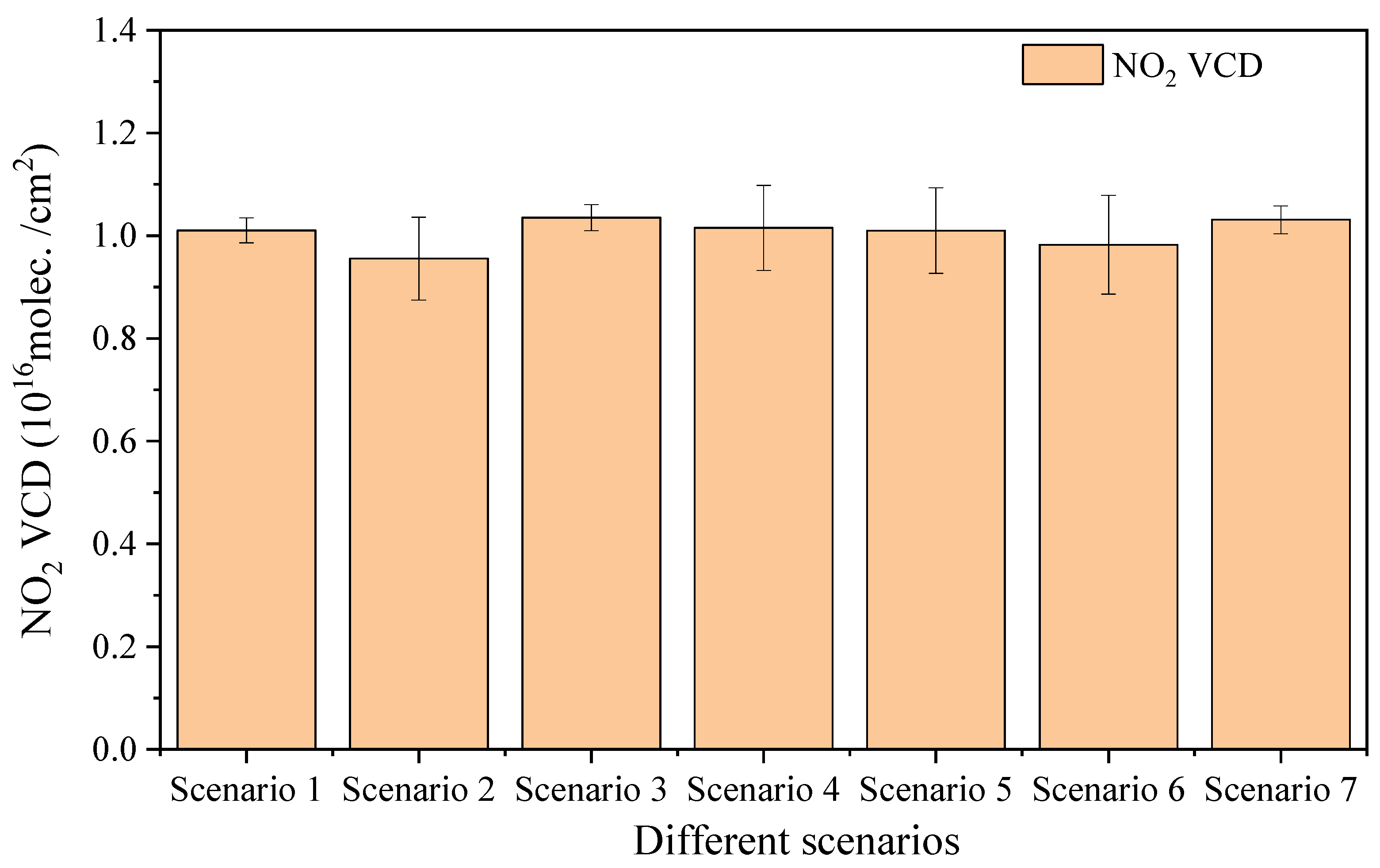
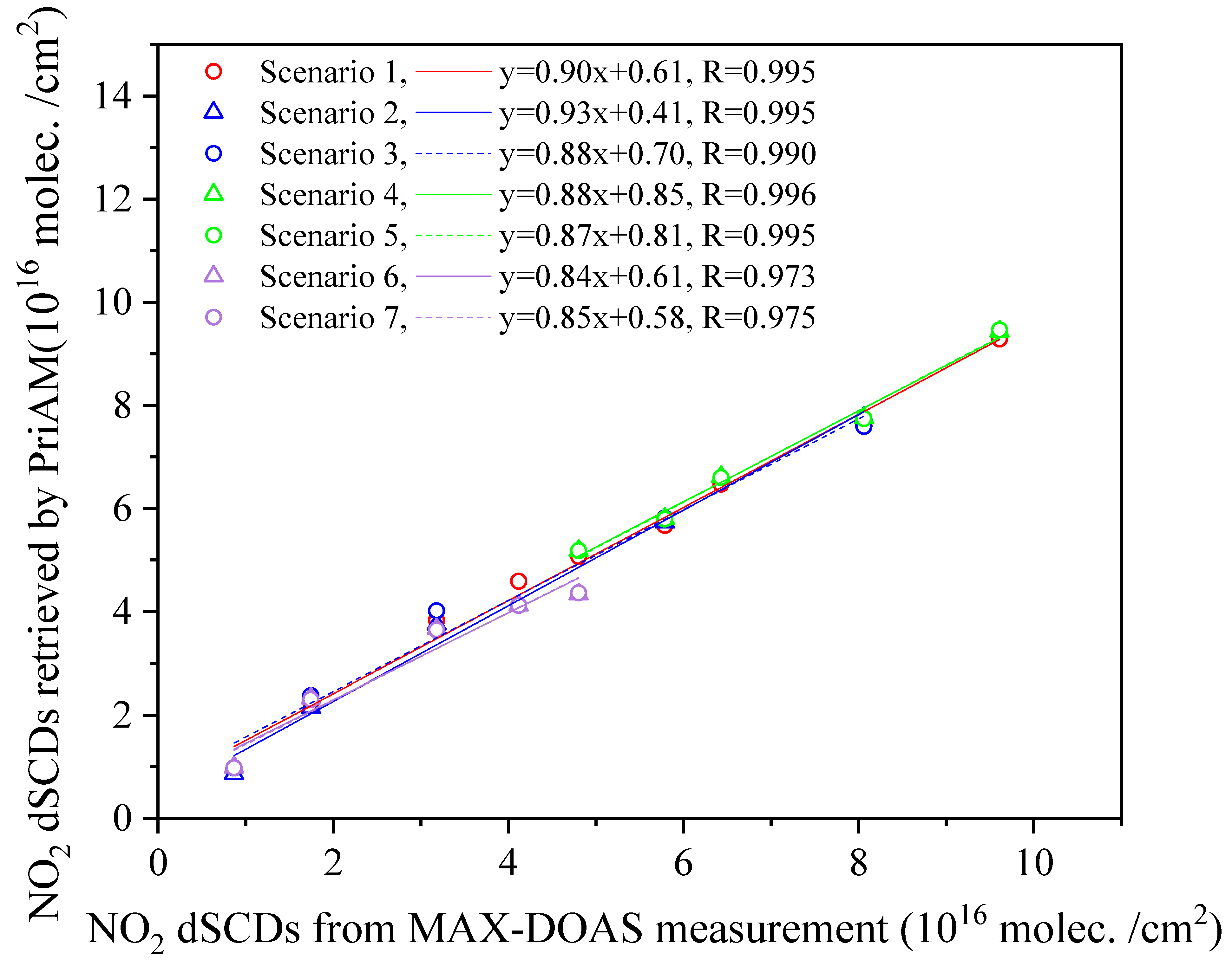
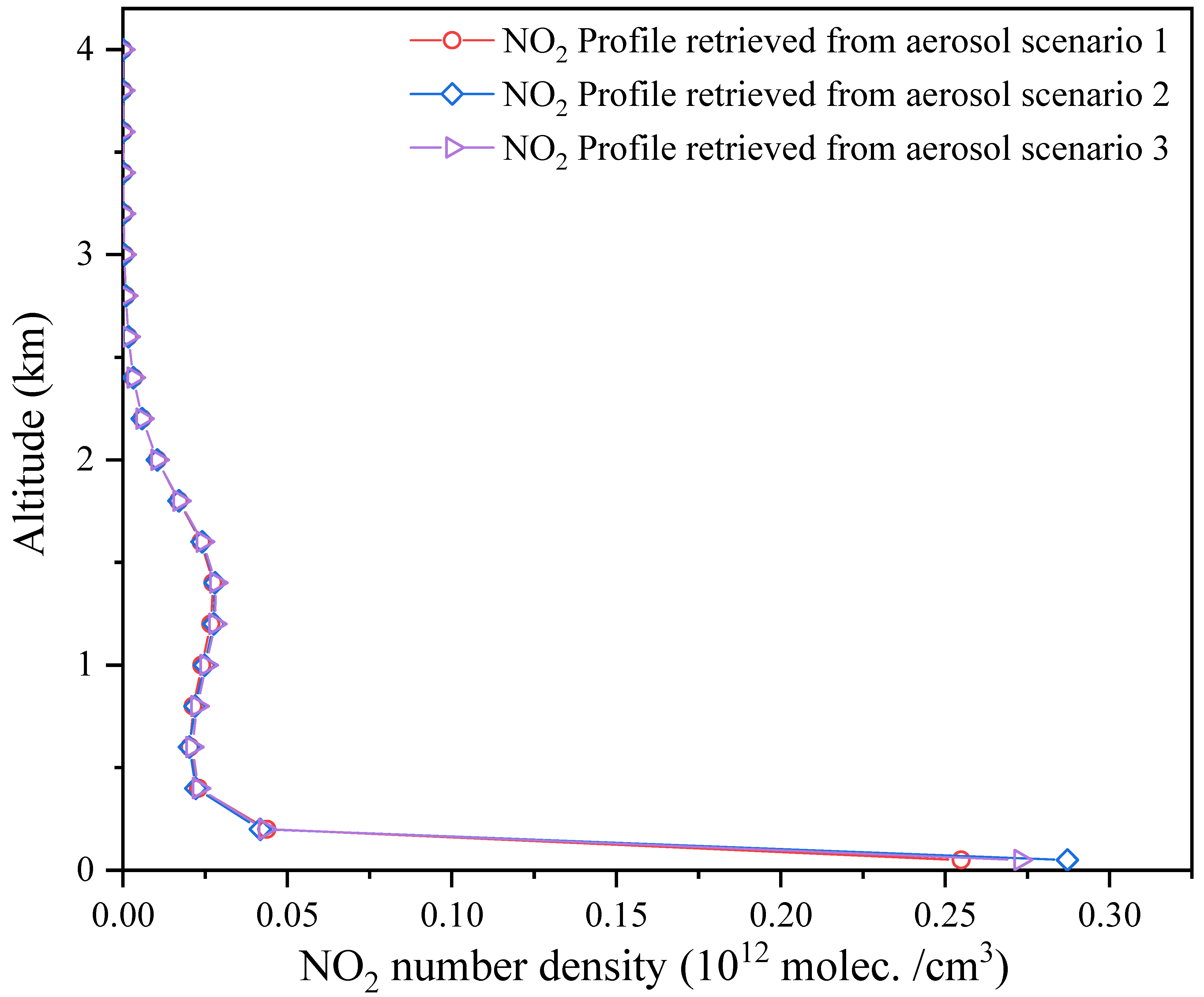
| Parameter | Source | Species |
|---|---|---|
| O4 and NO2 | ||
| Fitting spectral range | 338–370 nm | |
| NO2 (220 K, 294 K) | [31], I0-corrected (1017 molec. cm−2) | √ |
| O4 (293 K) | [32] | √ |
| O3 (223 K, 243 K) | [33], I0-corrected (1020 mole. cm−2) | √ |
| HCHO (297 K) | [34] | √ |
| BrO (223 K) | [35] | √ |
| Ring | RING_DOAS_SAO2010 [36] | |
| Polynomial degree | Order 5 (6 coefficients) | |
| Intensity offset | Constant | |
| Parameters | |
|---|---|
| Type of radiative transfer model | Scattered light in a spherical atmosphere |
| Vertical resolution | 200 m resolutions at an altitude range below 4.0 km |
| A priori profile | Aerosol: Boltzmann shape with an AOD of 0.3 and a height of 1.5 km (See Table S1 for details) NO2: Boltzmann input profile with a NO2 VCD of 1.0 × 1016 molec. cm−2 (See Table S1 for details) |
| Wavelength (nm) | 360 |
| Single scattering albedo (SSA) | 0.9 |
| Asymmetry parameter (AP) | 0.72 |
| Surface albedo | 0.06 |
| Solar zenith angle (SZA, °) | From observation |
| Relative azimuth angle (RAA, °) | From observation |
| Azimuth angle (°) | 0 (North) |
| Shape | Parameters | Scenarios | |||||||
|---|---|---|---|---|---|---|---|---|---|
| 1 | 2 | 3 | 4 | 5 | 6 | 7 | 8 | ||
| Boltzmann | Slope | 1.02 | 0.9 | 1.02 | 0.99 | 0.97 | 1.00 | 1.02 | 0.99 |
| Intercept | −46.50 | 16.02 | −54.86 | 13.69 | 60.41 | 4.91 | −45.07 | 14.14 | |
| R | 1.000 | 1.000 | 1.000 | 1.000 | 0.999 | 1.000 | 1.000 | 1.000 | |
| Gaussian | Slope | 0.99 | 1.00 | 1.02 | 0.99 | 1.00 | 0.99 | 1.02 | 0.99 |
| Intercept | 21.16 | 12.99 | −41.43 | 13.88 | −8.61 | 34.46 | −50.73 | 13.43 | |
| R | 1.000 | 1.000 | 1.000 | 1.000 | 1.000 | 1.000 | 1.000 | 1.000 | |
| Exponential | Slope | 1.01 | 0.99 | 1.01 | 0.99 | 0.99 | 0.98 | 1.02 | 0.99 |
| Intercept | −27.62 | 13.44 | −31.38 | 15.69 | 16.28 | 28.91 | −50.72 | 14.33 | |
| R | 0.999 | 1.000 | 0.999 | 1.000 | 1.000 | 1.000 | 0.999 | 1.000 | |
| Shape | Parameters | Scenarios | |||||||
|---|---|---|---|---|---|---|---|---|---|
| 1 | 2 | 3 | 4 | 5 | 6 | 7 | 8 | ||
| Boltzmann | DOFS | 1.95 | 1.95 | 1.58 | 1.58 | 1.73 | 1.73 | 1.10 | 1.10 |
| Hm | 1.4 | 1.4 | 1.6 | 1.6 | 1.2 | 1.2 | 1.6 | 1.6 | |
| Gaussian | DOFS | 1.95 | 1.95 | 1.55 | 1.55 | 1.73 | 1.73 | 1.06 | 1.06 |
| Hm | 1.6 | 1.6 | 1.8 | 1.8 | 1.6 | 1.6 | 1.8 | 1.8 | |
| Exponential | DOFS | 1.66 | 1.66 | 1.38 | 1.38 | 1.46 | 1.46 | 1.05 | 1.05 |
| Hm | 0.8 | 0.8 | 0.8 | 0.8 | 0.6 | 0.6 | 0.8 | 0.8 | |
| Shape | Parameters | Scenarios | |||||||
|---|---|---|---|---|---|---|---|---|---|
| 1 | 2 | 3 | 4 | 5 | 6 | 7 | 8 | ||
| Boltzmann | DOFS | 3.16 | 3.17 | 2.74 | 2.74 | 2.52 | 2.52 | 2.11 | 2.11 |
| Hm | 1.8 | 1.8 | 1.8 | 1.8 | 1.2 | 1.2 | 1.8 | 1.8 | |
| Gaussian | DOFS | 2.91 | 2.91 | 2.45 | 2.46 | 2.17 | 2.16 | 1.97 | 1.97 |
| Hm | 1.8 | 1.8 | 2.0 | 2.0 | 1.6 | 1.6 | 1.6 | 1.6 | |
| Exponential | DOFS | 2.89 | 2.91 | 2.52 | 2.52 | 2.37 | 2.41 | 2.03 | 2.03 |
| Hm | 1.4 | 1.2 | 1.2 | 1.2 | 0.8 | 0.8 | 1.2 | 1.2 | |
Disclaimer/Publisher’s Note: The statements, opinions and data contained in all publications are solely those of the individual author(s) and contributor(s) and not of MDPI and/or the editor(s). MDPI and/or the editor(s) disclaim responsibility for any injury to people or property resulting from any ideas, methods, instructions or products referred to in the content. |
© 2023 by the authors. Licensee MDPI, Basel, Switzerland. This article is an open access article distributed under the terms and conditions of the Creative Commons Attribution (CC BY) license (https://creativecommons.org/licenses/by/4.0/).
Share and Cite
Tian, X.; Chen, M.; Xie, P.; Xu, J.; Li, A.; Ren, B.; Zhang, T.; Fan, G.; Wang, Z.; Zheng, J.; et al. Evaluation of MAX-DOAS Profile Retrievals under Different Vertical Resolutions of Aerosol and NO2 Profiles and Elevation Angles. Remote Sens. 2023, 15, 5431. https://doi.org/10.3390/rs15225431
Tian X, Chen M, Xie P, Xu J, Li A, Ren B, Zhang T, Fan G, Wang Z, Zheng J, et al. Evaluation of MAX-DOAS Profile Retrievals under Different Vertical Resolutions of Aerosol and NO2 Profiles and Elevation Angles. Remote Sensing. 2023; 15(22):5431. https://doi.org/10.3390/rs15225431
Chicago/Turabian StyleTian, Xin, Mingsheng Chen, Pinhua Xie, Jin Xu, Ang Li, Bo Ren, Tianshu Zhang, Guangqiang Fan, Zijie Wang, Jiangyi Zheng, and et al. 2023. "Evaluation of MAX-DOAS Profile Retrievals under Different Vertical Resolutions of Aerosol and NO2 Profiles and Elevation Angles" Remote Sensing 15, no. 22: 5431. https://doi.org/10.3390/rs15225431
APA StyleTian, X., Chen, M., Xie, P., Xu, J., Li, A., Ren, B., Zhang, T., Fan, G., Wang, Z., Zheng, J., & Liu, W. (2023). Evaluation of MAX-DOAS Profile Retrievals under Different Vertical Resolutions of Aerosol and NO2 Profiles and Elevation Angles. Remote Sensing, 15(22), 5431. https://doi.org/10.3390/rs15225431






